
Vienna 7., The Spittelberg
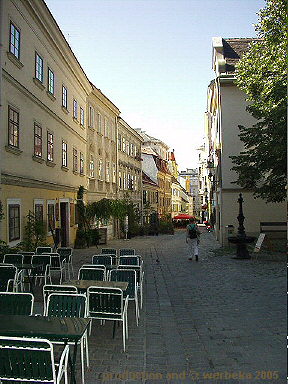 |
The Spittelberg is situated on a small hill in the seventh distrikt - to talk about a mountain (=berg) is by far exaggerated. The borders of the hill are Burggasse and Siebensterngasse on the long sides, the short sides are terminated by Breite Gasse and Neubaugasse. In general one thinks of the quarter between Breite Gasse and Stiftsgasse, when talking about the "Spittelberg" today. The reason is that this part has become a pedestrian area in the Seventies ... But let me start at the beginning.
There have been settlements on the Spittelberg for centuries already. At the time, when Vienna was surrounded by a city wall, the area was a suburb of Vienna, even if it was quite close to the city. Mainly gardeners and farmworkers were living there, supporting the city with fruits and vegetables. They often came from the countries on the Balkans, which were part of the Habsburg Empire. This is witnessed by the (today) pejorative name of "Krowotndörfl".
|
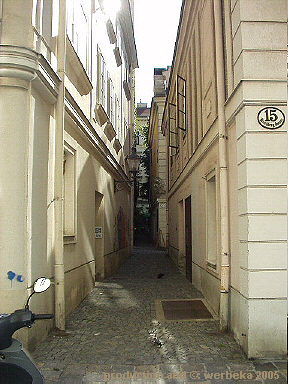 |
"Krowot" is the German "pronunciation" of the Croatian "Hrvat" and it means just Croatian. "Dörfl" is a diminutive of "Dorf", meaning village. On the other hand the denotation is used for all inhabitants of the Balkans, the Viennese people are not that particular ...
Because of its location, the Spittelberg was a strategic point, which also the Turks recognised in 1683. Like in most other villages outside of Vienna they looted and burnt the houses, using the hill in order to shoot into Vienna. The same strategy was used by Napoleon in 1809, when he attacked the capital. After the siege of the Turks this area was probably rather inexpensive, that is why it was bought by the Bürgerspital (=citizens hospital), which led to the name of "Spitalberg".
Again the surrounding area was used for farming, with mainly rather poor people living on the Spittelberg. This explains why the building density was high, with small alleys and without any green space in between.
|
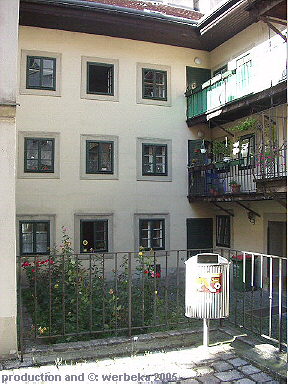 |
Because of that, the quarter became known as unhealthy and soon became notorious as a redlight-area, as well as a place of many drinking holes and scoundrels. Naturally the "St. Pauli of Vienna" or the "Montmartre of Vienna" held quite some attraction, not at least for the employees of the Emperors - so much more as it bordered directly to the imperial stables (the Museum Quarter of today). In the tavern of the "Witwe Nolte" one can still read the following: "Through this arc Joseph was shown his way out". This concerned Emperor Joseph II, the son of Maria Theresia, who reigned between 1780 and 1790. What Joseph was looking for there, I leave at the imagination of my readers.
In 1795 the Spittelberg became property of the city of Vienna, in 1850 it was made part of the sixth district, in 1861 of the seventh district. The name of the seventh district, "Neubau" (= new development) also allows conclusions. But there was still built closely and without any green areas.
|
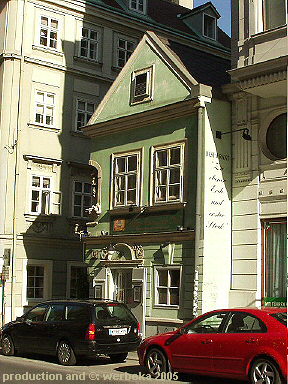 |
But now the Spittelberg became a reputation as a cultural quarter, maybe because in the time of the "Biedermeier" the impact of the daughters of joy was not as prominent. The name of the inn "Zu ebener Erde und im ersten Stock" (= On ground floor and one story up) is not by chance the same as a play by Johann Nestroy, the very typical playright of Vienna. A little further up the hill, the painter Friedrich von Amerling was born, descending from a family of craftworkers. Later on we shall talk more about the "Amerlinghaus", still standing there.
The ravages of time didn't stop at the new buildings either, and so the quarter decayed again and eventually got back its bad reputation.
Imposters, street artists and not at least the horizontal business revived a boom, especially after World War I. Many fathers had fallen in the war and could not any longer take care of their families. The surplus of women and too little income made the girls return to the streets. |
| |
The years of depression and World War II followed up the misery. Again the Spittelberg served mainly as unsufficient dwellings for immigrated guest-workers. Well, actually not even that. The quarter became so decrepit, that one was going to tear it down.
The idea was to build skyscrapers here. And now the Amerlighaus became important again. |
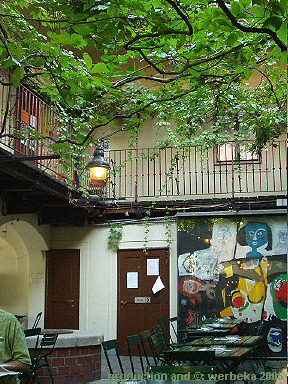 |
In the Seventies of the last century the house was occupied by groups supporting alternative lifestyles. They accomplished their goal, to keep the old buildings and to renovate the whole quarter.
In the courtyard of the Amerlinghaus, there is the "Amerlingbeisl", a plain inn with fancy surroundings. Other restaurants have settled on the Spittelberg as well, even gourmet restaurants. The people living there continue the tradition as well. Again you find artists and craftworkers of every kind and there are general stores and alternative shops.
Being that close to the Museum Quarter is a little problematic today, because the restaurants there "steal" a lot of customers. But if you are to visit the Museum Quarter, continue a couple of streets upwards - there you will find a left part of Old Vienna. Don't expect the Montmartre, though - that is to be found in Paris. Vienna is different. But the Spittelberg with all its history is well worth seeing. |
© Bernhard Kauntz, Wolvertem, Belgien 2013
Back to  or to the or to the  of of 
29.10.2013 by webmaster@werbeka.com
|

